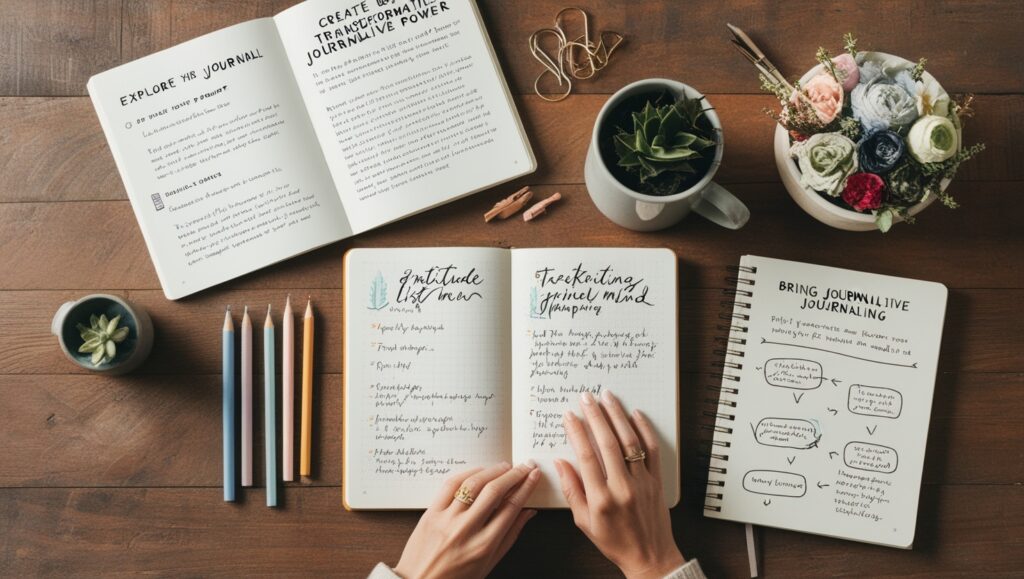Journaling Techniques for Clarity
Journaling is a transformative practice that offers clarity, self-reflection, and emotional well-being. It provides a safe space to organize thoughts, uncover insights, and manage stress. Journaling Techniques for Clarity But how can you harness its power effectively? This guide explores impactful journaling techniques that can help you achieve mental clarity and a deeper understanding of yourself.
1. Start with Morning Pages
Morning pages, popularized by Julia Cameron’s The Artist’s Way, involve writing three pages of stream-of-consciousness journaling first thing in the morning. This practice clears mental clutter, sparks creativity, and helps you set an intention for the day.
How to Begin:
- Write as soon as you wake up.
- Don’t worry about grammar or structure—just let your thoughts flow.
- Use this time to process dreams, anxieties, or goals.
2. Gratitude Journaling
Expressing gratitude shifts your focus from what’s lacking to what’s abundant in your life. Journaling Techniques for Clarity This technique fosters a positive mindset and brings clarity by helping you appreciate your blessings.
Steps to Practice:
- Write down three things you’re grateful for each day.
- Be specific (e.g., “I’m grateful for the warmth of my morning coffee” rather than “I’m grateful for coffee”).
- Reflect on why these things matter to you.
3. Use Prompts for Self-Discovery
Sometimes, staring at a blank page can be intimidating. Prompts offer direction and help you delve into specific areas of your life.
Sample Prompts:
- What is currently weighing on my mind, and why?
- What would I do if I knew I couldn’t fail?
- Who inspires me, and what can I learn from them?
4. Practice Reflective Journaling
Reflective journaling encourages you to analyze past experiences, understand your emotions, and identify patterns in your behavior.
How to Reflect:
- Write about a recent event—good or bad—and how it made you feel.
- Explore the lessons learned or how you could handle similar situations in the future.
- Acknowledge both your strengths and areas for improvement.
5. Mind Mapping for Clarity
If you feel overwhelmed or confused, mind mapping can help organize your thoughts visually. This method is particularly useful for brainstorming or solving problems.
How to Mind Map:
- Write a central idea in the middle of your page (e.g., “Career Goals”).
- Draw branches for related ideas or tasks, connecting them to the central theme.
- Expand each branch with actionable steps or insights.
6. Embrace Bullet Journaling
Bullet journaling is a structured yet flexible method that combines planning, reflection, and creativity. It helps you track habits, set goals, and maintain focus.
Basic Components:
- Index: A table of contents for easy navigation.
- Monthly and daily logs: Record tasks, events, and reflections.
- Collections: Create lists or themes like “Books to Read” or “Wellness Goals.”
7. Freewriting for Emotional Release
Freewriting involves pouring your emotions onto the page without overthinking. It’s a cathartic process that provides immediate mental relief.
How to Freewrite:
- Set a timer for 10–15 minutes.
- Write continuously without stopping, even if it feels repetitive.
- Let your subconscious guide you—there are no wrong answers.
8. Reflect on Your Goals and Progress
Journaling about your goals helps you stay focused and motivated. By documenting your progress, you gain a clearer understanding of your journey and challenges.
Steps to Follow:
- Write down long-term and short-term goals.
- Break them into smaller, actionable steps.
- Reflect weekly on what’s working and what needs adjustment.
9. Add Visualization Exercises
Combining journaling with visualization helps bring your dreams to life. Writing about your ideal future can enhance clarity and set you on the path to achieving it.
How to Visualize Through Journaling:
- Write a detailed description of your dream life, career, or relationships.
- Include sensory details—how does it look, feel, or sound?
- Reflect on steps you can take to align your current actions with this vision.
10. End with Evening Reflections
Evening journaling allows you to process the day and prepare for restful sleep. Use this time to review your achievements, challenges, and moments of joy.
Evening Prompts:
- What went well today, and why?
- What challenges did I face, and how did I overcome them?
- What is one thing I’m looking forward to tomorrow?
Final Thoughts
Journaling is a versatile tool that adapts to your needs, whether for emotional release, self-discovery, or goal-setting. Experiment with these techniques to find what resonates most with you. Journaling Techniques for Clarity As you build a consistent practice, you’ll uncover insights, achieve clarity, and cultivate a deeper connection with yourself.
Start your journaling journey today—one word, one thought, one page at a time!

